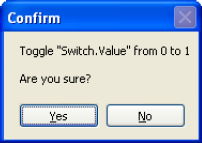TGML JavaScript Functions
The following is an overview of the TGML JavaScript functions unique for TGML:
| Method | Description |
|---|---|
|
alert("‹message›") |
Displays a message box. |
|
clearInterval(intervalID) |
Cancels the interval previously started using the setInterval function. |
|
clearTimeout(timeoutID) |
Cancels a time-out that was set with the setTimeout function. |
|
confirm("‹message›") |
Displays a confirm box with "Yes" and "No" buttons. |
|
execute("‹command›") execute("‹command›", "‹options›") |
Requests an execute operation to be performed by the TGML viewer (start a Windows program). NOTE: The implementation of this function is system dependent. May not be implemented in some systems. |
|
invoke("‹bindingName›", "‹operation›") |
Requests an operation to be performed on a bound object by the TGML viewer. The bindingName is the full name (as it is exposed to the binding tools) of a Bind or Link element. NOTE: The implementation of this function is system dependent. May not be implemented in some systems. |
|
openFile("‹path›", "‹operation›") |
Requests the TGML viewer to open a file. The operation is typical Windows object verbs. NOTE: The implementation of this function is system dependent. May not be implemented in some systems. |
|
prompt("‹message›", "‹defaultValue›") |
Prompts the user to enter a value. |
|
setForce("‹bindingName›", "true|false") |
Sets the force state of a bound signal object. The bindingName is the full name (as it is exposed to the binding tools) of a Bind element. NOTE: The implementation of this function is system dependent. May not be implemented in some systems. |
|
setInterval("‹expression›", "‹milliseconds›") |
Evaluates (executes) the expression each time the specified number of milliseconds has elapsed. |
|
setTimeout("‹expression›", "‹milliseconds›") |
Evaluates (executes) the expression after the specified number of milliseconds has elapsed. |
|
setValue("‹bindingName›", "‹value›") |
Sets the value of a bound signal object. The bindingName is the full name (as it is exposed to the binding tools) of a Bind element. NOTE: The implementation of this function is system dependent. May not be implemented in some systems. |
*This is valid for the TGML specific implementations and may be removed in future releases. Made obsolete in favor of the JavaScript standard implementation.
TGML JavaScript Functions - Example 1
This is an example of how to create an interactive rectangle that toggles a value.
<TGML>
<Component Name="Switch" Left="50" Top="50" Width="102" Height="102" ContentHeight="102" ContentWidth="102">
<Rectangle Left="l" Top="l" Width="100.0" Height="100.0" Fill="#C0C0C0" Stroke="#000000">
<Script OnMouseClick="click"
OnSignalChange="signal"><![CDATA [
currentValue = NaN;
function click(evt)
{
var rect = evt.getTarget();
var oldVal = new Number(currentValue);
// Note: currentValue is set in function signal.
if (!isNaN(oldVal)) // Skip if no value has arrived
{
// Toggle
var newVal = (oldVal==0) ? 1 : 0;
// Get the Bind element (named Value)
var bind = rect.getChild("Value");
// Get the full binding name
var fullName = bind.getFulIBindName();
var toggle = confirm("Toggle \"" + fullName + "\" from " + oldVal + " to " + newVal + "\n\nAre you sure?");
if(toggle == true)
setValue(fullName, newVal);
}
// The rect contains a Bind element. Cancel the
// default viewer action (do not display the
// default "edit value" dialog).
evt.preventDefault();
}
function signal(evt)
{
var currentValue = evt.getValue ();
}
] ]></Script>
<Bind Attribute="Fill" Name="Value">
<ConvertValue AttributeValue="#FF0000" SignalEqualTo="0"/>
<ConvertValue AttributeValue="#00FF00" SignalEqualTo="l"/>
</Bind>
</Rectangle>
</Component>
</TGML>

TGML JavaScript Functions - Example 2
The example below assumes that the Link named "Report" is bound to a TACOS report object. The function invoke will result in a "print report" operation in Diagrams.
<TGML>
<Text Left="100" Top="100">
Print TACOS report
<Script OnMouseClick="click"><![CDATA [
function click(evt)
{
var rect = evt.getTarget();
var link = rect.getChild("Report");
var fullName = link.getFullBindName();
// Print the linked report
invoke(fullName, "PrintReport");
// The text contains a Link. Cancel the default
// Link operation
evt .preventDefault();
}
]] ></Script>
<Link Name="Report"/>
</Text>
</TGML>
TGML JavaScript Functions - Example 3
This example starts an interval timer and animates (toggles) the fill color when the cursor is over the rectangle. The timer is stopped and the color is restored when the cursor leaves the rectangle.
<TGML>
<Rectangle Fill="#FFFFFF" Height="100.0" Left="100.0" Stroke="#000000" Top="100.0" Width="200.0">
<Script OnMouseOut="out" 0nMouseOver="over"><![CDATA [
var intervalID;
var rectangle;
var originalColor;
var animatedColor;
function over(evt)
{
// Store the rectanle element and the original color
rectangle = evt.getTarget();
originalColor = rectangle.getAttribute("Fill");
// Initialize the animated color and set this color
animatedColor = "#FF0000";
rectangle.setAttribute("Fill", animatedColor);
// Start the timer
intervallD = setlnterval(toggleColor, 500);
}
function out (evt)
{
// Stop the timer and restore the color
clearlnterval(intervallD);
rectangle.setAttribute("Fill", originalColor);
}
function toggleColor()
{
if(animatedColor == "#FF0000")
animatedColor = "#0000FF";
else
animatedColor = "#FF00Q0";
rectangle.setAttribute("Fill", animatedColor);
}
] ]></Script>
</Rectangle>
</TGML>
TGML JavaScript Functions - Example 4
This example displays an alert box when the cursor has been over the rectangle for one second. The timer is stopped when the cursor leaves the rectangle.
<TGML>
<Rectangle Fill="#FFFFFF" Height="100.0" Left="100.0" Stroke="#000000" Top="100.0" Width="200.0">
<Script OnMouseOut="out" 0nMouseOver="over"><! [CDATA [
var timeoutID;
function over(evt)
{
// Start the timer.
// Evaluate "alert('Hovering')" after 1 second
timeoutID = setTimeout("alert('Hovering')", "1000")
}
function out(evt)
{
// Stop the timer (abort)
clearTimeout(timeoutID);
}
]]></Script>
</Rectangle>
</TGML>